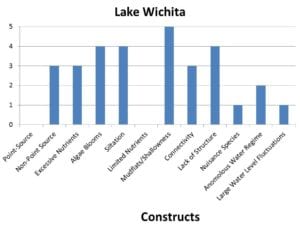Lake Wichita watershed is dominated by farmland and grazing land, and its riparian zone is highly urbanized. The result? Extremely high phosphorus and nitrogen loading, high sedimentation, and high runoff.

In March of 2004 a toxic golden alga event killed approximately 7,700 fish of which 93% were non-game fish. In March of 2007 another event occurred with an estimated 15,000 fish (primarily non-game species) dying. In February of 2009, a much larger golden alga event killed greater than 200,000 fish, including many game fish. In early 2012, another major kill occurred caused by a toxic golden alga bloom. Also in 2012, a prolonged drought significantly decreased water levels driving water temperatures and dissolved oxygen to lethal levels, resulting in two fish kill events that likely killed off all fish life. In 2014, Lake Wichita was nearly completely dry but rebounded in May 2015 when torrential rains filled the lake and water again went over the spillway.
There is an axiom that goes something like “what happens in the watershed ultimately shows up in the reservoir.” Lake Wichita is a prime example of this axiom. On hundred years plus of sediment and nutrients entering the reservoir resulted in a shallow, nutrient rich reservoir which would not support fish. Couple this with extended droughts caused the problems to intensify. Invasive salt cedar and mesquite in the watershed “sucked up” most of the potential runoff needed to fill the reservoir during wet periods. Lake Wichita could not survive under these conditions.
When the habitat is degraded beyond a certain point a complete restoration is the only way to provide a sustainable solution. The restoration must start with corrective measures in the watershed. A plan to address the salt cedar and mesquite is key to ensure adequate runoff to keep the lake filled once sediment is removed to increase storage capacity.




